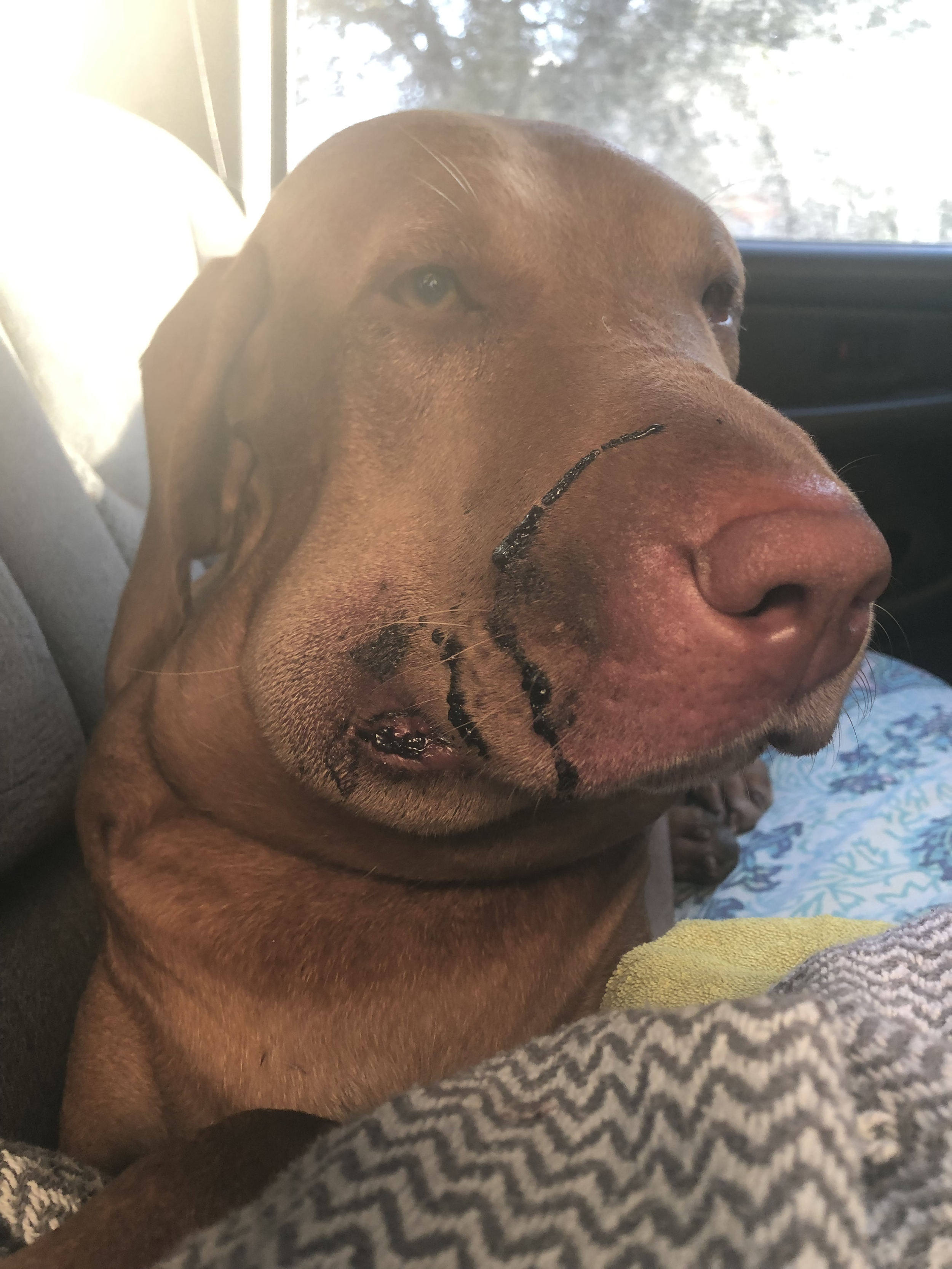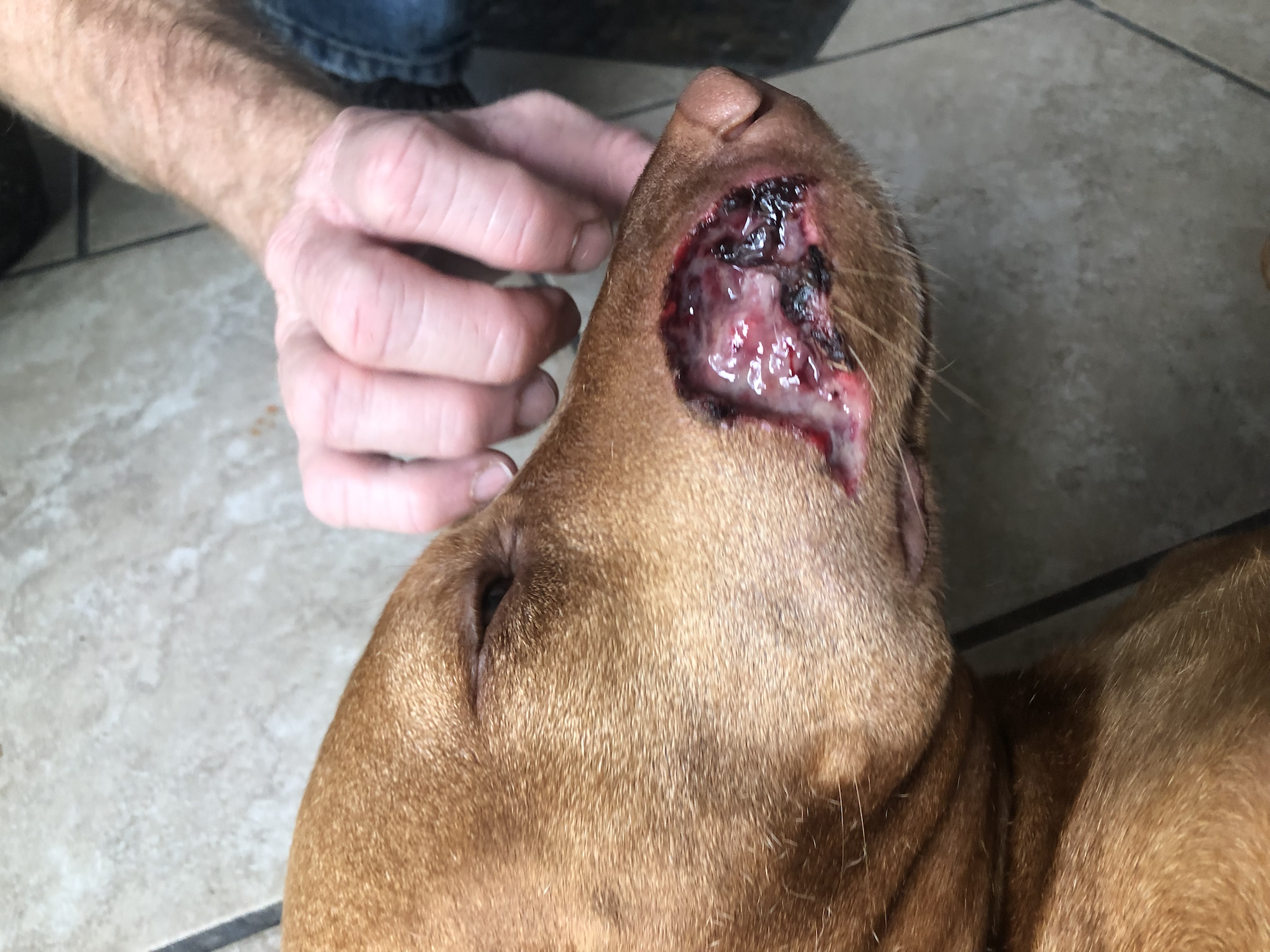Herbal Lifeline: My Dog’s Snakebite Survival Story
How to use Herbs to Assist Healing in Snakebites
Warning: This blog contains graphic images of a snake bite in a dog. While this story tells of our experience, please use your own discretion and liability when making these decisions for your pet. Always encourage to seek the advice of a professional.
In Texas, rattlesnakes are about as common as cowboy boots—if you haven’t seen one yet, just wait!
Despite their ecological importance in controlling rodent populations and maintaining balance in Texas ecosystems, rattlesnakes are dangerous. Their venomous bites can cause severe injury or even death to humans and pets, especially if provoked or accidentally encountered.
Their venom contains potent toxins that can rapidly damage tissue and disrupt vital body functions, making immediate medical attention essential after a bite. While rattlesnakes generally prefer to avoid confrontation, their presence in both rural and urban areas means accidental encounters—and the risk of envenomation—remain a real concern for people and animals in Texas.
At the Liferoot Ranch & Homestead, snakes are common. We usually let them be, unless they are getting too comfortable in our area (which rarely happens). Snakes like chicken eggs, compost bins, mice, and all sorts of things that naturally occur around a homestead. But even despite that, usually they want to keep to themselves. We don’t see them often.
Growing up in Texas, we were taught about snakes. What things to do, what not to do. That works for humans (sometimes), and dogs (sometimes).
You can try to teach a dog all you want, but in the end, they’ll always follow where their nose leads them. And that’s what happened to Iris, our dog that was almost killed by a rattlesnake.
The dogs love to run around in the grassy areas, chasing lizards, mice etc. They are usually close to us just exploring the perimeter around the work area.
We heard Iris yelp in pain. Rushing over, Brad saw the unmistakable double puncture marks and swelling: she’d been bitten by a snake. We immediately took her to the vet, and within an hour, she was tended to quickly.
At the clinic, the vet was very concerned. After examining our dog, she explained the severity: the snake had delivered a full envenomation, injecting all its venom.
The vet quickly began emergency treatment—administering intravenous fluids, pain medication, and monitoring for shock and tissue damage. In cases like this, antivenom is the gold standard and most effective if given within the first 6 hours, but not every clinic has it available, and it can be prohibitively expensive. Our dog was hospitalized for observation, as is standard for severe snake bites, and we were told to prepare for a difficult night.
The vet called that afternoon in tears (which threw us off a bit), saying it was serious and she wasn’t sure if Iris would make it. They had done all they could, and told us we could bring her home.
Turning to Herbal Wisdom: A Conversation with Sam Coffman
At the time, I was taking some herbal medic courses online through the Herbal Medics Academy.
I was in a class involving wound care, and happened to have a zoom meeting with my class that evening. My instructor was Sam Coffman—a former Green Beret medic and clinical herbalist renowned for his expertise in herbal first aid. Sam listened to our story and, drawing on his experience, recommended a specific herbal formula to support our dog’s recovery alongside the vet’s care.
He was glad that we had sought higher care in this case, and told us that herbs are excellent in helping the body recover. He told us stories of how he had used a formula in the field to help animals and humans recover from snake bites. He emphasized that emergency care was always the best option, but herbs can be there to assist before getting to higher care, and help the body recover from the trauma of envenomation. We were so grateful to him and his willingness to help. He gave us specific instructions and we followed them. We definitely had nothing to lose at this point, and were willing to try anything.
Antivenoms & Medicinal Plants- A great combo for complete recovery
While our story includes both modern and plant antivenoms, each one has its own benefits. When used together, they can offer a more complete healing process. Medicinal plants and modern antivenoms both offer ways to counteract snake venom, but their properties, effectiveness, and limitations differ significantly.
Modern Antivenoms
Mechanism: Modern antivenoms are produced by immunizing animals (usually horses or sheep) with small amounts of snake venom and then collecting and purifying the resulting antibodies. These antibodies bind and neutralize venom components in the bloodstream.
Strengths: Antivenoms are highly effective at neutralizing the systemic (whole-body) effects of snake venom, such as neurotoxicity and coagulopathy, especially when administered promptly after a bite.
Limitations: Antivenoms often do not address local symptoms like tissue necrosis, hemorrhage, or kidney damage caused by venom. They can also cause allergic reactions, require refrigeration, and are expensive and sometimes unavailable in rural or resource-limited settings.
Medicinal Plants
Mechanism: Medicinal plants contain a variety of bioactive compounds (e.g., phenols, alkaloids, triterpenoids, flavonoids) that can inhibit specific venom enzymes or neutralize certain toxic effects. Some plant extracts have demonstrated the ability to prolong blood clotting time, inhibit hemorrhage, or reduce tissue damage in laboratory and animal studies.
Strengths:
Plants are often more accessible, affordable, and stable than antivenoms, especially in rural areas.
Some plants not only neutralize venom but also help repair tissue damage, which is a limitation of conventional antivenoms.
They may have broad-spectrum activity against various venoms, though most evidence is for monovalent (single-species) effects.
Limitations:
The efficacy of medicinal plants is mostly supported by traditional use, in vitro, and animal studies; there is a lack of robust clinical trials in humans.
Most plant extracts are only effective against specific venom types, and their activity is not as rapid or comprehensive as antivenom therapy.
No plant-based anti-snake venom is commercially available or standardized for clinical use.
The precise dosage, safety, and toxicity profiles of many plants remain under-researched.
The Herbal Formula and Our Dog’s Recovery
Following Sam’s advice, after we received traditional antivenom at our vet office, we used a blend of herbal remedies designed to boost immune function, reduce inflammation, and support healing. The core of the formula included:
Echinacea root extract: Known for its immune-boosting and anti-inflammatory properties, Echinacea has a long history in both Native American and Western herbal traditions as a remedy for venomous bites. We gave our dog Echinacea tincture internally and used it to clean the wound (diluted with water). We diluted the tincture with broth, to make it more palatable for our dog.
Prickly pear cactus pads (Opuntia spp.): Applied topically, the gel from prickly pear pads acts as a soothing, drawing poultice to reduce swelling and inflammation.
Vitamin C & Turmeric: Given orally in solution, vitamin C and turmeric is thought to support tissue healing and reduce oxidative stress after envenomation.
Being an herbalist myself, I knew of some other herbs that could assist in her healing.
Chaste Tree (Vitex species) has been traditionally used to help with snake bites, as preparations from its parts have been applied as antidotes or supplements to treat envenomation, potentially by neutralizing some effects of the venom.
Plantain (Plantago major) has traditionally been used as a folk remedy for snake bites, with its leaves applied as a poultice to the wound to help reduce inflammation and promote healing.
Ginger, specifically dried ginger, has been used in traditional medicine for snake bites by combining it with other herbs to form a paste that is administered orally, where it acts as a purgative and emetic to help expel venom from the body.
Within 24 hours, we saw a dramatic improvement. The swelling receded, our dog’s energy returned, and by the end of the second week, she was back to her old self. The combination of veterinary intervention and herbal support made all the difference.
She still had several weeks of healing in her face, but we knew she was heading in the right direction. Using cold water to help rejuvenate the skin on the face was also a lifesaver. Here was our exact protocol.
Dog Snake Bite Protocol:
In 1/4 cup broth, put two droppers of Botanic Rescue tincture. Let this warm, to burn off alcohol in tincture. Dogs are very intolerant to alcohol in any form, so always best to take precautions. Let cool to palatable to tongue, and give to dog via syringe or let dog lap up if they are able. 1/4 cup a day (can be split up in several doses a day). We did this for 1-2 weeks.
Note: The first 48 hours are crucial to get the tincture consumed. Use a syringe if needed.
Applying cold water to a snake bite wound can help soften and loosen old, dead skin (slough) around the injury, making it easier to gently remove during the healing process. This practice can also help soothe the area, reduce irritation, and promote a cleaner environment for new, healthy skin to grow. We rinsed (with a hose on very low) the area for 2 weeks.
Apply prickly pear cactus gel. Open the cactus, and apply gel if needed. We only did this a couple of times, as our dog didn’t like it too much.
Here are some photos of Iris over the course of the two weeks.
*Warning: graphic images follow:
This was right after she was bit, on the way to the vet
24 hours after she left the vet, she was feeling well enough to come in the car. You can see how the swelling has settled into her neck
4 days in. Venom kills tissue, so you can see her skin starting to fall off
Using a cool gentle water stream to get off old dead tissue
One week in. Most of the side of her face tissue is dying, and will regrow
2 weeks in. Closing up nicely now
1.5 weeks in. You can see the tissue is regrowing
Three Weeks in. Closed up!
Final Thoughts
Snake bites are a true emergency—never delay higher care if possible.
But as our experience shows, herbal remedies can play a valuable role in supporting the snake bite and recovery.
Herbs such as Echinacea, turmeric, prickly pear, and plantain have centuries of traditional use and are increasingly recognized for their potential to aid healing after envenomation.
Always work with your vet and a knowledgeable herbalist to ensure the best outcome for your beloved pet.









